Tucked in the heart of the American West is Colorado, the nation’s 38th state. It encompasses most of the Rocky Mountains, as well as the western edge of the Great Plains. Colorado is known for many things, but its breathtaking natural landscapes and diverse wildlife are two of the most popular reasons people visit the state. Though it is a well-loved destination throughout the year, the winter months in particular are a great time to visit. Snowmobiling, skiing, ice skating, and snowshoeing are just a few activities that are sure to get you in the winter spirit. Having said that, wildlife watching is another great way to spend your time. Even though elk, deer, moose, and mountain lions are frequently spotted throughout this season, there’s a wide variety of birds that stay year-round as well. Continue reading to discover the 10 most common birds that spend their winters in Colorado!
Do All Bird Species Migrate in the Winter?
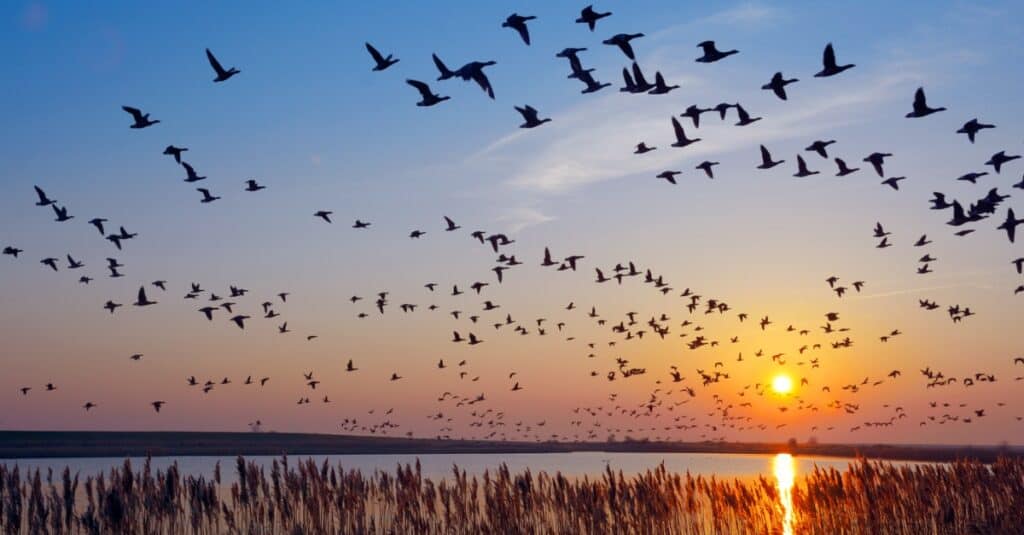
Many experts believe that climate change may cause migratory birds’ bodies to get smaller.
©eurotravel/Shutterstock.com
It is natural for birds to make their homes in places that provide them with adequate food, climate, and daylight hours. This is why many bird species throughout the world migrate to more suitable places before winter commences. This annual migration commonly begins in August and lasts through November. That being said, September and October are the busiest months for bird migrations in North America. In fact, over 75% of all birds in North America migrate for the winter.
The most common migratory pattern for birds in this region is to fly north in the spring to mate, then return to warmer regions in the fall. Some bird species — like starlings (Sturnus starling) and geese (Anser anser) — migrate in small flocks. Alternatively, other kinds of birds form large groups of thousands or even millions. This is the case for Sandhill Cranes (Grus canadensis), which form flocks of up to 6000,000 birds.
Nevertheless, there are some bird species that choose not to migrate for the winter. According to scientists, certain environmental cues initiate bird migrations. When it is time for birds to begin their annual migration, a lack of available food is one of the most critical indicators. Because of this, if food always remains available for birds in any given area, some species will delay migration or not leave at all. Now, let’s explore 10 of the most popular birds that spend their winters in Colorado instead of migrating.
1. Dark-Eyed Junco (Junco hyemalis)
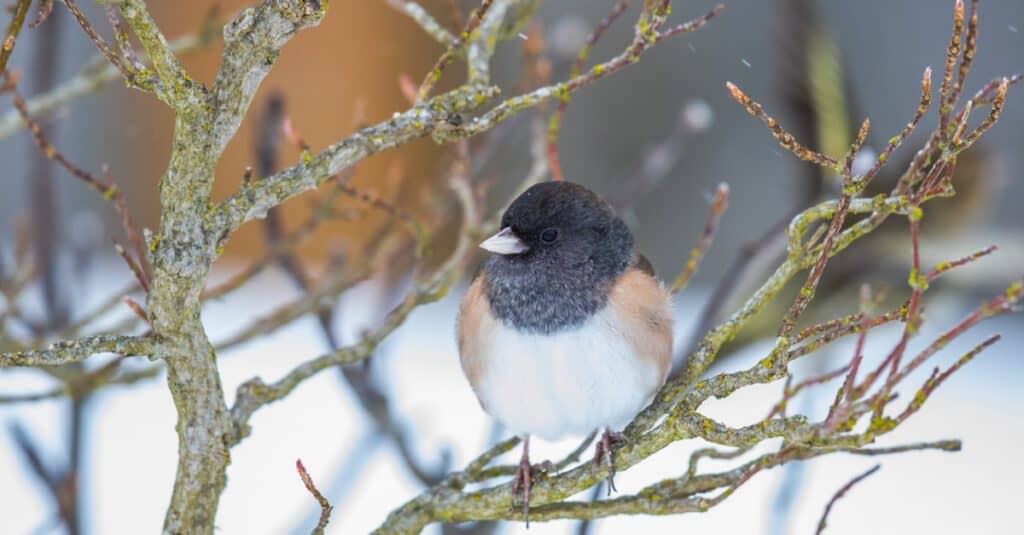
Juncos are also called Colorado snowbirds.
©iStock.com/Jeff Huth
The Dark-Eyed Junco (Junco hyemalis) is a subspecies of junco, which are small New World sparrows. They are found all across temperate North America, with some spotted as far north as the Arctic. In the wild, a dark-eyed junco can live to be up to 11 years old. Their population is stable and thriving. Currently, there are approximately 630 million dark-eyed juncos in the wild!
In Colorado, Estes Valley and Rocky Mountain National Park are the most frequent locations for spotting this species. In the summer, they prefer spruce-fir, pine, and aspen forests. Alternatively, in the winter, dark-eyed juncos make their homes in open woodlands, fields, parks, or even in people’s backyards. This is mainly because food is plentiful in these areas — even throughout the winter months. Luckily for them, many of these birds utilize seed feeders as their primary sources of food throughout Colorado’s long winters.
2. Black-Capped Chickadee (Poecile atricapillus)
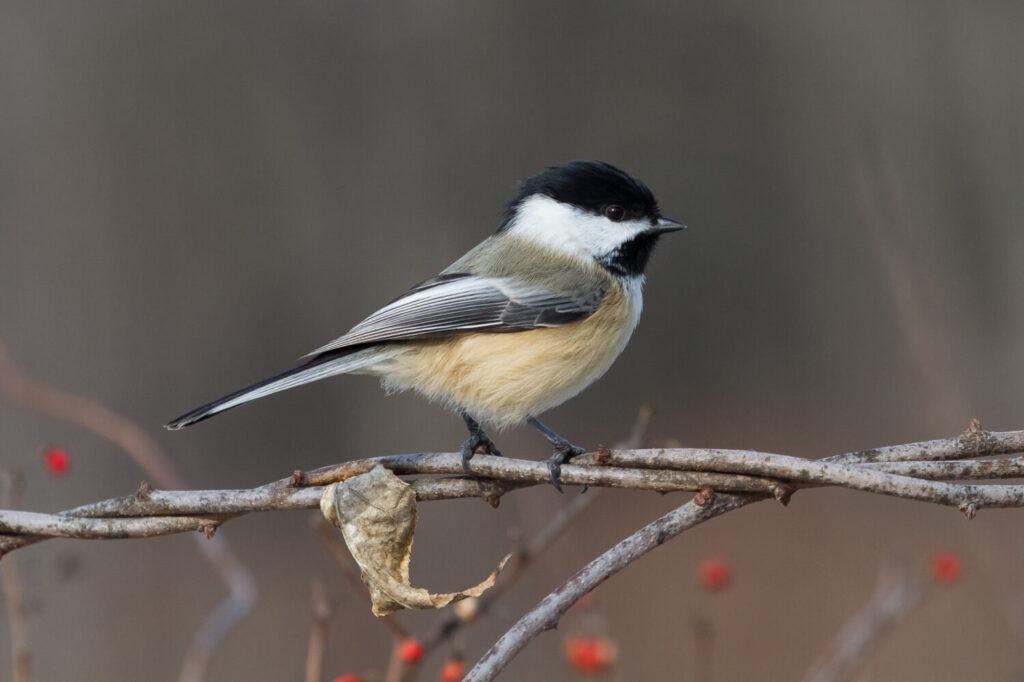
Black-capped chickadees are a popular bird to spot in Colorado during the winter.
©Paul Roedding/Shutterstock.com
Overwintering is a process in which animals change their appearance or lifestyle habits to survive the winter. Most birds migrate to warmer areas or places with a greater abundance of food, but others choose to stay put. IWhen that happens, the birds that endure the season’s frigid temperatures have to get creative to find adequate food and warmth. In the case of black-capped chickadees, they group together to stay warm. Serving as a perfect example of a species that adapts to survive, these birds learned several tricks for surviving winters in Colorado.
First, they have a built-in fur coat. To explain, they develop dense winter feathers that work to trap heat and prevent — or hide — shivering. Secondly, these birds fluff their feathers to increase insulation and reduce their surface area-to-volume ratio. These evolutionary measures work so well, in fact, that black-capped chickadees can maintain body temperatures of over 100 degrees Fahrenheit even if the outside air is below 0 degrees!
3. Townsend’s Solitaire (Myadestes townsendi)
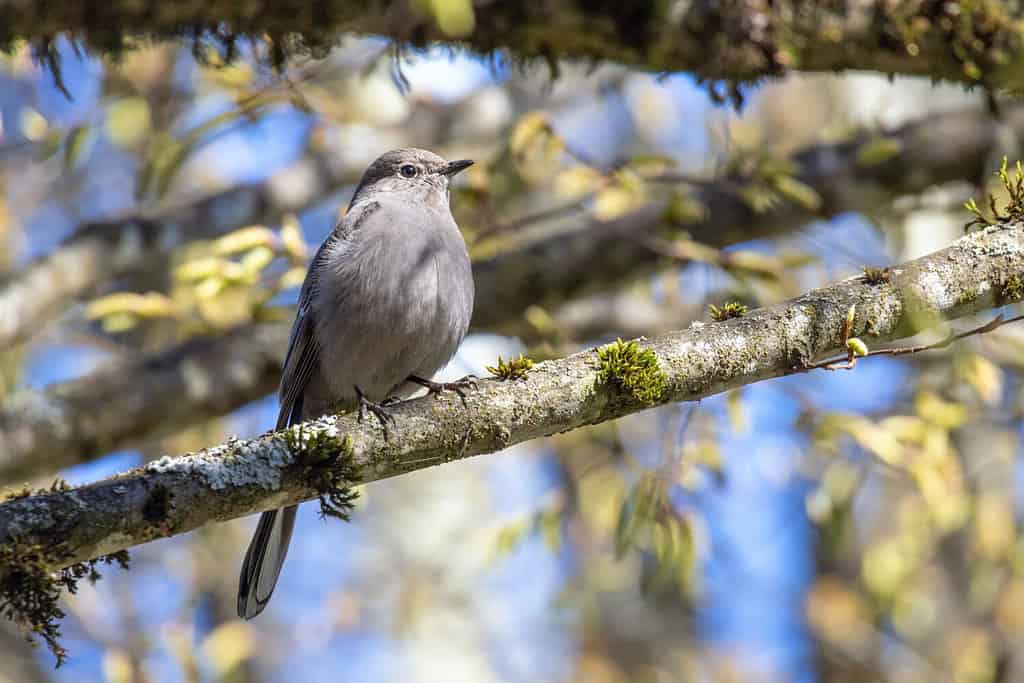
The Townsend’s Solitaire typically nests on the ground and prefers finding a nesting location along cut banks.
©Feng Yu/Shutterstock.com
Weighing an average of 1.2 ounces, Townsend’s Solitaires are elegant songbirds known for their ground-level nests and melodious singsongs. They typically inhabit shrubby areas, open pine forests, or juniper woodlands. Townsend Solitaires are frequently spotted in Colorado’s mountainous regions between 1,100 and 11,500 feet, as well as near Wigwam Creek, Palmer Lake Reservoir, and Beaver Creek State Wildlife Area. During the winter months, they flock to Colorado Springs.
When the temperature starts dropping, Townsend’s Solitaires diet consists mainly of berries, whereas in the summer, they consume a bounty of insects, seeds, and wild fruit. Throughout winter, their main means of survival is by staking out a prime juniper grove and nesting nearby. During this time, they maintain a solitary status and aggressively defend their territory until warmer weather — and more food sources — start to roll in. Having said that, they are known as solitary birds (hence the name) and are rarely spotted in groups.
4. Cedar Waxwing (Bombycilla cedrorum)
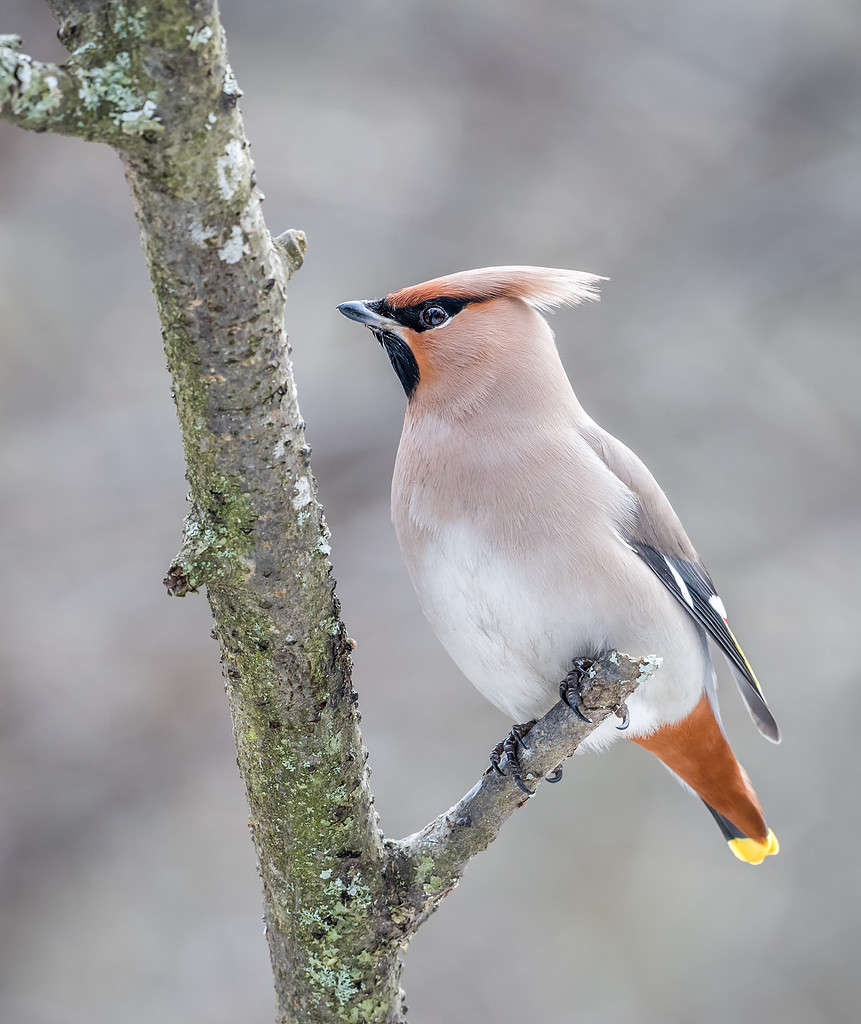
Cedar waxwings are medium-sized passerine birds, characterized by their brown, gray, and yellow color.
©hannurama/iStock / Getty Images Plus via Getty Images
Named for its wax-like wing tips, the cedar waxwing is one of the few bird species in North America that primarily feeds on fruit. This species can survive on berries for months and is often seen eating cedar berries, juniper, honeysuckle, crab apples, cherries, and holly berries. They are one of the most common birds that spend their winters in Colorado. Cedar waxwings are found just about anywhere in the state, but predominately nest in areas of Pine Valley Ranch, Cherry Creek Trail, Estes Park, and Monument Valley Park. If you are hoping to spot one this winter, they are also attracted to backyard bird feeders that are stocked with cranberries, raisins, chopped grapes, or apple pieces.
5. American Crow (Corvus brachyrhynchos)
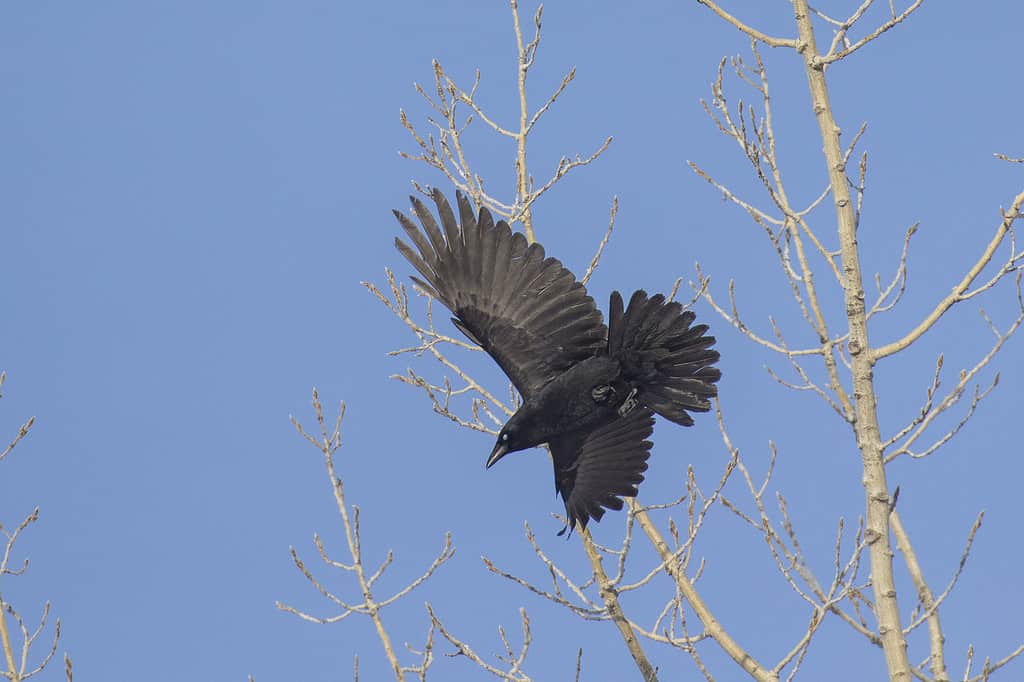
American crows are one of the smartest bird species in the world, with their intelligence ranking at the same level as chimpanzees!
©iStock.com/1381721614
Functioning best in groups, called murders, American crows are highly social birds. They maintain a year-round nesting territory in close proximity to all of their extended family. In their groups, they socialize, communicate, and forage together. During the fall and winter seasons, crows leave on their own to join larger flocks in agricultural fields, farmlands, orchards, protected nature parks, or suburban areas. When the weather gets cold, they sleep in large roosts and huddle with one another to stay warm throughout the winter months. Typically, these gatherings consist of anywhere from 100 to over a million crows! Unlike many other birds on this list, they are not territorial or aggressive, instead opting to share food and information about where to find food with other crows in their groups. This helps increase all of their chances of survival during the winter.
6. Blue Jay (Cyanocitta cristata)
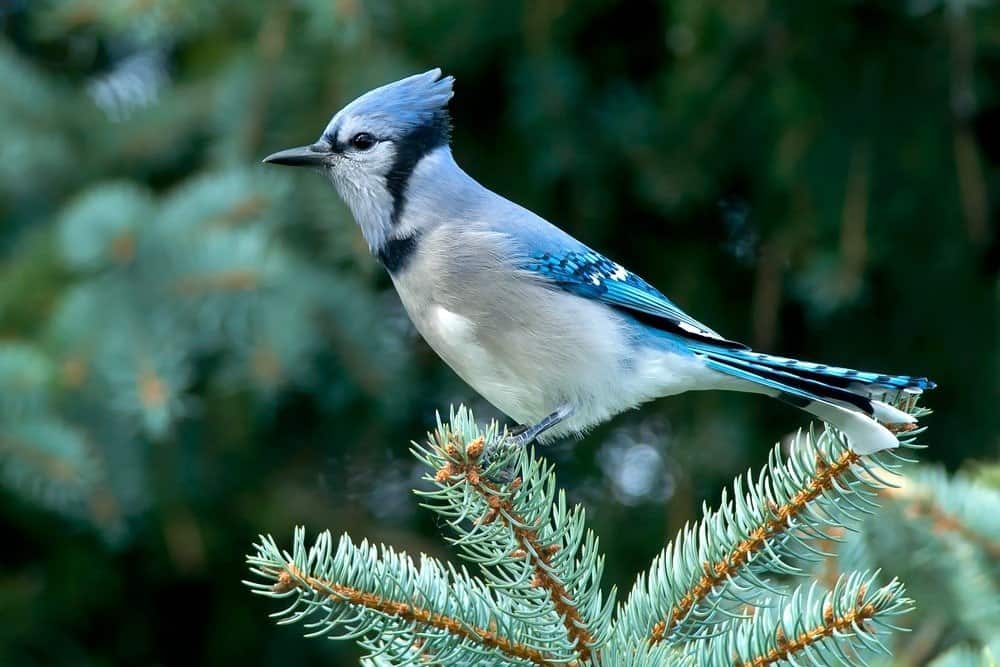
Blue Jays typically stick it out through Colorado’s frigid winters.
©Paul Reeves Photography/Shutterstock.com
Known as America’s favorite blue bird, blue jays are large-crested songbirds with broad, rounded tails. They are most identifiable by their white or light gray underbellies and dark blue outer feathers. This bird displays distinct black and white markings on its wings, tail, head, and chest. The blue jay is commonly identified by its loud calls.
Despite being a year-round resident of Colorado, this bird species is most frequently seen in and around Boulder. This is particularly true during the spring mating season, which runs from March to August. They prefer to nest in places with lush evergreen forests, oak and pine woods, or suburban parks and gardens. During the winter, they go into hiding due to the lack of foliage that would otherwise help hide them from hawks and other bigger birds that stay in Colorado for the winter. Because of this, they are fairly hard to spot, but rest assured, they are all around. So next time you are in Colorado for the winter, keep an eye, or an ear, out and maybe you will get a chance to spot one of these striking birds for yourself!
7. Downy Woodpecker (Picoides pubescens)

The downy
woodpecker
is built to withstand Colorado’s cold winter temperatures.
©J Edwards Photography/Shutterstock.com
Downy woodpeckers are the smallest of all the woodpecker species in North America. This bird reaches a maximum of 7 inches in length. They have a wingspan of 10 to 12 inches long. Furthermore, downy woodpeckers are characterized by their straight, chisel-like bills, straight-backed posture, and blocky heads. They also have notoriously small beaks for their size, which is readily apparent when compared to other woodpeckers. Like other woodpeckers, they are mainly black on their upperparts and wings. This bird species has a white back, throat, and underbelly, with some white spotting near their wings as well as above and below each eye. Moreover, the red nape of male downy woodpeckers sets them apart from females.
Downy woodpeckers are another one of the most common birds that spend their winters in Colorado. They generally survive off of insects and fly larvae living on or in the stems of weeds and trees. They survive winters in Colorado by roosting in new nesting cavities, most often in dead or dying trees. These spaces shelter the birds from the outside temperatures while also providing protection from predators. Alternatively, many downy woodpeckers use artificial nesting boxes to survive the frigid winter temperatures in Colorado.
8. Nuthatches (Sitta carolinensis)

People often mistake nuthatches for woodpeckers because of their long, pointed beaks and unique foraging behaviors.
©iStock.com/M. Leonard Photography
There are three main nuthatches that you can find in Colorado during the winter. The first is the white-breasted nuthatch. These magnificent birds are compact, with short tails and a long, sharply pointed beak. They have blue to gray back feathers, pure white cheeks, and black cap head markings. Red-breasted nuthatches also stay in Colorado year-round. This subspecies has easy-to-spot cinnamon-colored underparts. They also have a black stripe across their eyes. The last kind of nuthatch — and arguably the most unique — is the pygmy nuthatch. This bird species averages 4 inches long and weighs anywhere between 0.3 and 0.4 ounces. Though incredibly tiny, pygmy nuthatches are incredibly active, even during Colorado’s coldest time of year!
All three of these nuthatches are year-round residents of the Rocky Mountain region of Colorado. They prefer to nest in pine forests, conifer woods, and mature deciduous forests. Red-breasted nuthatches, specifically, like to nest in canyon country, which is why there are so many sightings around the Lyons area in Colorado. To survive the winters in this state, these birds stay in mixed flocks, huddle together for warmth, and go into torpor when necessary. Torpor is a state of “mental and physical inactivity” similar to bears in hibernation. During this time, nuthatches make use of controlled hypothermia to slow their body’s natural functions, conserving energy and heat. They also utilize caching, the act of hiding food to retrieve and eat later. This ensures they have enough food to get them through the winter season, even if food sources are scarce.
9. American Robin (Turdus migratorius)
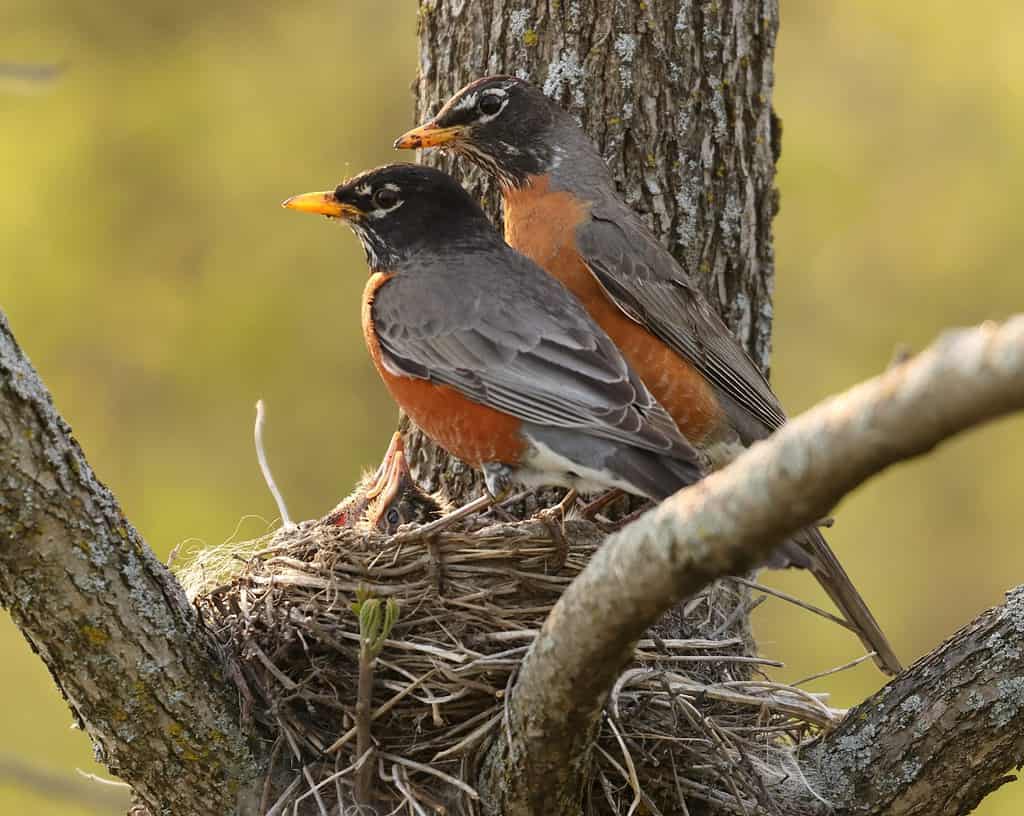
Female American robins lay bright blue eggs, which is the source of the color “robin’s egg blue”.
©yvontrep/Shutterstock.com
One of the most common birds in the United States is the American robin. They have black heads and black back feathers. Robins also generally have a vibrant patch of red or orange breast feathers. They grow to about 11 inches in length and weigh an average of 3 ounces. American robins thrive in a variety of environments, including woodlands, forests, mountains, parks, or suburban backyards. They mainly eat earthworms, insects, snails, and local fruits and berries.
While robins are found throughout Colorado, a large number of them reside in Colorado Springs and the Rocky Mountains. During winter, it is common for birds of this species to move their nests to lower elevations where the temperatures are milder. Interestingly enough, experts believe the ongoing effects of climate change have affected American robins’ natural migratory patterns. Due to steadily rising temperatures, these birds are no longer moving their nesting grounds as they did in past years. For now, keep an eye out for these stunning birds if you are planning a winter vacation to Colorado!
10. Pine Siskin (Spinus pinus)

Pine siskins are wonderful mothers, known to stay on the eggs continuously throughout Colorado’s cold winter months.
©Menno Schaefer/Shutterstock.com
In the finch family, pine siskins are small and weigh anywhere between 0.4 to 0.6 ounces. They measure 4.3 to 5.5 inches long. With streaky brown feathers and subtle yellow edges on their wings and tails, these birds’ coloration is quite unique. You can set them apart from finches by looking at their bills and tails, which are much thinner and shorter.
They are concentrated in Estes Park, which is the perfect environment for them due to the prevalence of pine trees in the area. Their migration habits are erratic and based solely on the success of cone crops in the area. If the crops are abundant, pine siskins will stay in Colorado for the winter. To help get them through the chilly winter months, this bird species has the ability to increase their metabolic rates by up to 40% higher than normal levels. This helps them maintain energy and keep their internal body temperatures up, which is especially important during the frosty winter months.
Summary of the Top 10 Birds That Spend Their Winters in Colorado
| Number | Bird |
|---|---|
| 1. | Dark-Eyed Junco |
| 2. | Black-Capped Chickadee |
| 3. | Townsend’s Solitaire |
| 4. | Cedar Waxwing |
| 5. | American Crow |
| 6. | Blue Jay |
| 7. | Downy Woodpecker |
| 8. | White- or Red-Breasted Nuthatch |
| 9. | American Robin |
| 10. | Pine Siskin |
The photo featured at the top of this post is © Tom Zeman/Shutterstock.com
Thank you for reading! Have some feedback for us? Contact the AZ Animals editorial team.







